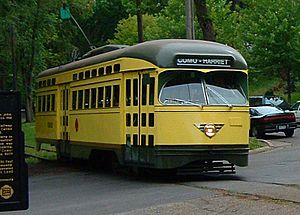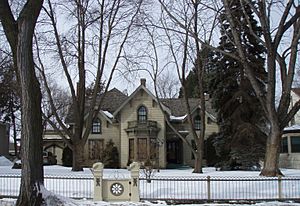Morningside, Minnesota facts for kids
Morningside is a special neighborhood in Edina, Minnesota. It's known for its unique buildings and history. Morningside started as an old "streetcar suburb" right next to the Linden Hills area of Minneapolis.
Back then, Morningside grew quickly because it was located along the old Como-Harriet Streetcar Line. This made it easy for people to travel. Edina, on the other hand, was mostly farmland. In 1920, the people of Morningside decided to separate from Edina. They wanted to form their own village to get services that fit their needs as a busy streetcar suburb.
Contents
A Growing Community
Morningside's growth shows how suburbs developed in the Twin Cities area. Many homes were built close together. The houses looked similar, and people relied on public transport like the streetcar. Between about 1905 and 1936, developers built hundreds of new single-family homes. Many of these were bungalows. They were built on regular-sized lots along straight streets. This land used to be farms and apple orchards.
The Grimes Family and Early Development
The Morningside neighborhood was planned for homes in 1905. This happened when the children of Jonathan Grimes took over his farm and apple orchard. The Grimes farm was in the northeast part of the village. Today, Grimes Avenue runs through the neighborhood from north to south. The Jonathan Taylor Grimes House on West 44th Street is a historic building. It was added to the National Register of Historic Places in 1976.
Morningside's Marshal: George Weber
George Weber was a very important person in early Morningside. In 1929, the mayor of Morningside asked 55-year-old George Weber to be the village marshal. He was already the school janitor. At first, he said no to the job. But the village council voted him in anyway.
Weber stayed in charge of Morningside for 27 years. He retired in 1956. After he left, the Edina Village Police started protecting Morningside. Weber's wife helped run the police station at 4400 Branson Street. George Weber also read water meters and took the census. Court was held twice a month at the Edina Grange Hall. Today, there is a park in Morningside named after George Weber.
A Welcoming Community
In 1960, the first Black family moved into the Morningside neighborhood. Some people in the community were not welcoming at first. However, many residents supported the new family. A petition for fairness was signed by 251 Morningside residents. This showed that most of the community was not prejudiced.
Rejoining Edina
Morningside was its own village for 46 years. But in 1966, it became part of the larger City of Edina again. This happened partly because the state encouraged it. The people of Morningside voted to rejoin Edina. It was hard for such a small village to build its own sewage system.
Even today, Morningside feels different from the rest of Edina. You can see this difference in just a few blocks. For example, compare the Morningside/Minneapolis intersection at 44th and France to the Edina/Minneapolis intersection at 50th and France. The name Morningside is still used for local groups, roads, and businesses.
Community Spirit
Even though it's part of Edina, Morningside has a strong sense of independence. There are about 750 homes in the neighborhood. This independence comes from the close relationships among neighbors. Many events and organizations help build these connections.
The Morningside Babysitting Cooperative has been around for almost 100 years. It still helps members share childcare hours. The Morningside Woman's Club started in 1937. It was first called the Morningside Literary Club. Morningside also has an active Neighborhood Association. This group speaks up for the neighborhood's unique needs at City Hall. There is also a men's group called the Morningside Athletic Club (MAC). They meet every Saturday morning at Weber Park for sports like soccer, football, and ice boot hockey.
| Historical population | |||
|---|---|---|---|
| Census | Pop. | %± | |
| 1930 | 903 | — | |
| 1940 | 1,282 | 42.0% | |
| 1950 | 1,699 | 32.5% | |
| 1960 | 1,981 | 16.6% | |
| U.S. Decennial Census | |||



